by tmoffett | Jul 26, 2010 | Color, Landscape, Photo tips
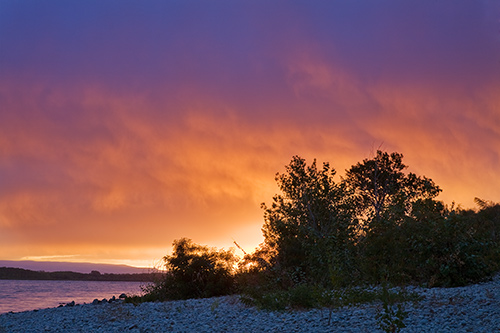
Sunset, Gotts Point
We have had some great sunsets lately, and I love being out at the lake when they happen. No matter how many sunsets I photograph, or see for that matter, I am always wanting to see more. Each one is different and unique. Photographing the sunset to capture its beauty and intensity can be somewhat difficult as well. There are a few things we can do to enhance our vision and capture an image that is more than just another sunset.
First, I want to make sure that I know what the main subject is. Is it the sunset or is it something else with the sunset as the backdrop? Nearly always I will have some other element in the image, but most of the time it is secondary to the sunset, however it is just as important as the sunset. Placement of the foreground elements must be carefully selected.
Second, shoot when the balance of light between foreground and background is ideal. Do you want a complete silhouette or do you want to see detail and color in the foreground elements? In the image above, I wanted to see detail, so I waited until the light on the rocks and trees were about 1.5-2 stops darker than the sunset, and then I made the photograph. Had I waited another 5 minutes, then the trees and rocks would have been completely black. There is very little time to work if you are looking at this kind of balance. You must be set up before the light gets where you want it. A spot meter helps in determining the light ratio and know when to shoot.
Third, use a tripod and cable release. This can not be emphasized enough. I am a firm believer in tripod use. I lock the camera mirror up and use a cable release nearly all of the time. It makes for sharper images. It forces me to slow down and think. I like to make every shot count. Editing is easier this way. I have fewer photographs, but am able to print a very high percentage of what I shoot. I like it that way.
Using these techniques will allow you to do almost everything in camera. You will have very little editing and Photoshop work to do on the image after importing to the computer. This saves a tremendous amount of time and energy as well increases final image quality.
by tmoffett | Jul 25, 2010 | Color, Landscape, Ramblings
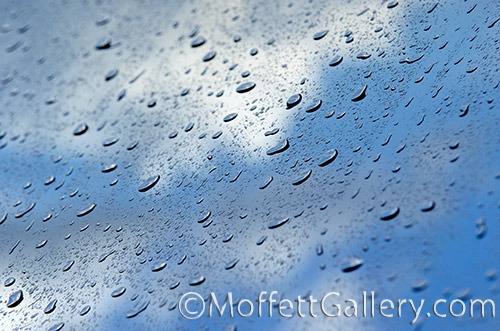
Blue Sky and Raindrops
Weather. It is so unpredictable. I was out photographing one late afternoon with the most perfect weather, then almost out of nowhere came the rain. I retreated to the car as the rain was really coming down. Just a few minutes later, it cleared off again and I was able to resume shooting. That is the kind of weather we have in Idayo. If you don’t like it, wait 10 minutes.
While I was sitting in the car, I watched as the rain came down on the windshield. Each drop would hit and then bead up on the glass. It was quite interesting to watch. Just as it stopped, the sky began to clear and this scene opened up to view. I grabbed my camera and made a couple of exposures before resuming to shoot outdoors. As I focused on the drops from inside the car, I could see the sky, soft on blurry, in the background.
I guess my point today is to always be on the lookout for images. Be observant. Learn to see. There are opportunities wherever we are to be creative. It really isn’t about where you are, but how and what you see.
by tmoffett | Jul 24, 2010 | Color, Composition, Landscape, Photo tips
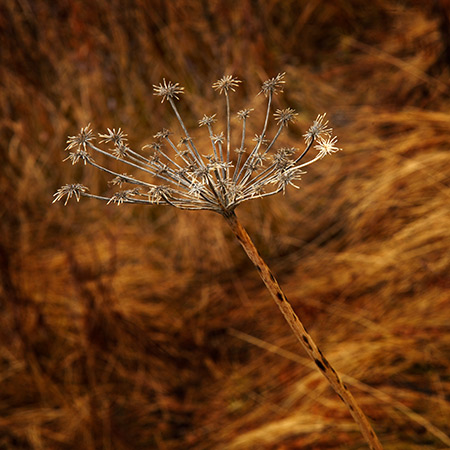
Just a Weed
I know, it’s just the dried up remnants of a weed. I wish I knew the name of the plant so I could at least title it correctly, but I guess I didn’t study enough botany in school. Even though it is just a weed, look at the visual qualities of the image. The line and texture make it interesting to look at. The top of the plant is bursting out from the stem, almost like fireworks exploding from a mortar. By keeping the one plant sharp and blurring the background, even though both are the same color, the plant stands out, it separates from the background.
Controlling depth of field, so vital in creating photographs. I know, it is the technical stuff that many of us don’t want to get in to, but it is necessary if we are going to be in control of our art. With this image, I used a 70mm lens and moved in as close as it would focus. Due to being so close to the subject, my depth of field was very narrow, so much so that the near and far parts of the weed were out of focus, even at a moderately wide aperture. I actually needed to stop down to f16 to maintain crisp focus on the weed, but due to how close I was to it, the background fell off to a nice blur.
There are three things that factor in to effective depth of field. 1. Aperture 2. Focal length of the lens 3. Lens to subject distance. All three of these play a part in determining what will be in focus and what will not. We, as photographers must know our equipment and how to use it. In the example above, had I just thought that due to needing shallow depth of field I should set the aperture to f2.8, I would have been terribly disappointed. I am glad that I have learned the technical aspects of photography to the point of really not having to think about it so that I can focus on composing and creating art!
by tmoffett | Jul 23, 2010 | Black and White, Composition, Ramblings
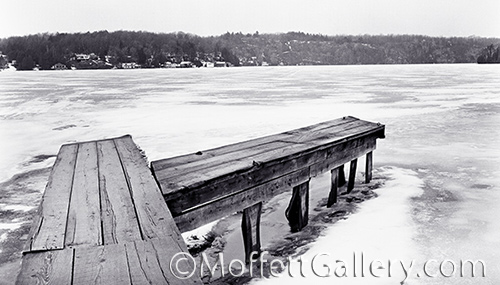
Iced Over
In an effort to wish cooler temperatures here, I am going to the archives and posing a winter picture today. This comes from a long time back when I was in Watertown, New York. One winter day I was out driving and came upon this old pier at a lake that I am not even sure what its name is. Anyway, it was cold. The pier was icy. I remember slipping and nearly falling on its icy surface while setting up this image. I love the angle on the pier as well as the texture, contrasting nicely with the icy snow covered lake.
This brings back memories of the days of film. I shot this with my Pentax 6×7 on Kodak TMAX 100 film. Occasionally I long for those days. The smell of fixer in the darkroom. Watching the image appear in the tray. Those little things that really hooked me on photography. Everything is so different now, yet in some ways it is the same. The tools have changed, but the concepts remain. The computer has become my darkroom. Many of my students today have never shot with film. They only know digital. I sometimes think that they are missing so much by not having played in the darkroom. The darkroom teaches a person to slow down and think about what they are doing. Nothing was instantaneous like it is now. So different.
by tmoffett | Jul 22, 2010 | Color, Composition, Landscape, Photographic Philosophy
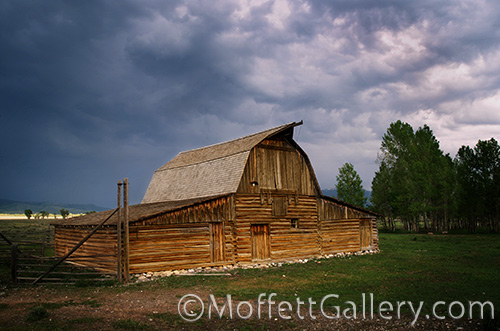
Old Barn near Jackson Hole, WY
Why is it that landscape photographers are drawn to old barns? I normally like my landscapes clean, but when there is an old barn in the scene, I will photograph it. All other man made objects or structures I want removed, but an old barn can stay.
I happened upon this barn just as the rain passed and I was able to watch the sun set while I photographed. The nice, soft, warm light of the setting sun with the storm clouds overhead made for a very nice composition. That is one thing that I try always to be aware of when shooting. What is the sky doing? If the sky does not enhance the image, then how can I minimize it? In this case, I love the sky, so I made sure to include it in the image. Remember, the background, in this photo, the sky, can make or break the photograph.







Recent Comments